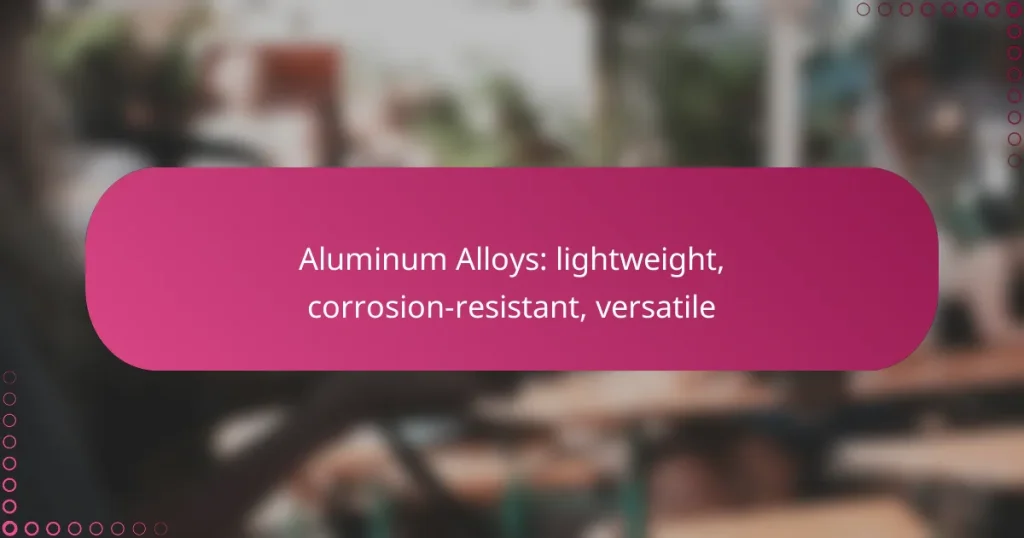Aluminum alloys are renowned for their lightweight, corrosion-resistant, and versatile properties, making them essential in various industries. Alloys like 6061, 7075, and 2024 are particularly favored for their strength and workability, catering to diverse industrial applications. The natural formation of a protective oxide layer enhances their resistance to corrosion, ensuring durability in demanding environments.

What are the best aluminum alloys for lightweight applications?
The best aluminum alloys for lightweight applications are typically those that balance strength, corrosion resistance, and workability. Alloys such as 6061, 7075, and 2024 are popular choices due to their specific properties that cater to various industrial needs.
6061 aluminum alloy
6061 aluminum alloy is widely used in lightweight applications due to its excellent corrosion resistance and good mechanical properties. It is often chosen for structural components, automotive parts, and marine applications.
This alloy can be easily welded and machined, making it versatile for different manufacturing processes. Its strength-to-weight ratio is favorable, typically ranging from 240 to 310 MPa, depending on the temper.
7075 aluminum alloy
7075 aluminum alloy is known for its high strength, making it ideal for applications where weight savings are critical without sacrificing performance. It is commonly used in aerospace and military applications.
This alloy has a lower corrosion resistance compared to 6061, so protective coatings are often recommended. Its tensile strength can reach up to 570 MPa, making it one of the strongest aluminum alloys available.
2024 aluminum alloy
2024 aluminum alloy is another high-strength option, primarily used in aerospace applications where weight reduction is essential. It offers excellent fatigue resistance and is often found in aircraft structures.
While it has good machinability, it is less corrosion-resistant than 6061 and 7075, requiring protective measures in certain environments. The tensile strength of 2024 can be around 480 MPa, making it suitable for demanding applications.

How do aluminum alloys resist corrosion?
Aluminum alloys resist corrosion primarily through the formation of a protective oxide layer that forms naturally when aluminum is exposed to oxygen. This layer acts as a barrier, preventing further oxidation and degradation of the underlying metal.
Protective oxide layer
The protective oxide layer on aluminum alloys is typically a few nanometers thick and forms almost instantly when aluminum is exposed to air. This layer is composed mainly of aluminum oxide, which is stable and adheres strongly to the metal surface, effectively blocking moisture and corrosive agents from penetrating. In environments where exposure to saltwater or industrial pollutants is common, this oxide layer is crucial for maintaining the integrity of the alloy.
In some cases, the oxide layer can be enhanced through anodizing, a process that thickens the oxide layer and improves corrosion resistance. Anodized aluminum can withstand harsher conditions, making it suitable for applications in marine environments or chemical processing.
Alloying elements
Aluminum alloys often include various alloying elements such as copper, magnesium, and zinc, which can significantly influence their corrosion resistance. For example, magnesium enhances resistance to seawater corrosion, making it ideal for marine applications. However, some alloying elements can reduce corrosion resistance if not properly balanced.
When selecting an aluminum alloy for a specific application, it is essential to consider the environment it will be exposed to. For instance, alloys with higher copper content may be more susceptible to pitting corrosion in chloride-rich environments, while those with silicon may perform better in high-temperature applications. Understanding these characteristics can help in choosing the right alloy for optimal performance and longevity.

What are the applications of aluminum alloys in various industries?
Aluminum alloys are widely used across multiple industries due to their lightweight, corrosion-resistant, and versatile properties. These characteristics make them ideal for applications where strength and durability are essential while keeping weight to a minimum.
Aerospace industry
In the aerospace industry, aluminum alloys are crucial for manufacturing aircraft components, including fuselages, wings, and engine parts. Their high strength-to-weight ratio allows for fuel efficiency and improved performance.
Common aluminum alloys used in aerospace applications include 2024 and 7075, which are known for their excellent mechanical properties. Compliance with aerospace standards, such as those set by the Federal Aviation Administration (FAA), ensures safety and reliability in flight operations.
Automotive industry
The automotive industry utilizes aluminum alloys to reduce vehicle weight, enhance fuel efficiency, and improve overall performance. Components like engine blocks, wheels, and body panels are often made from aluminum to achieve these goals.
Alloys such as 6061 and 5754 are popular choices due to their balance of strength and formability. As regulations around emissions tighten, the shift towards lighter materials like aluminum is becoming increasingly important for manufacturers aiming to meet standards.
Construction industry
In construction, aluminum alloys are valued for their durability and resistance to corrosion, making them suitable for structural applications, window frames, and roofing materials. Their lightweight nature simplifies handling and installation processes.
Alloys like 6063 and 6082 are frequently used in architectural applications, offering both aesthetic appeal and structural integrity. Understanding local building codes and regulations is essential when selecting aluminum for construction projects to ensure compliance and safety.

What factors should be considered when selecting aluminum alloys?
When selecting aluminum alloys, key factors include the intended application, required strength, corrosion resistance, and weldability. Understanding these characteristics helps ensure the chosen alloy meets performance and durability needs.
Strength-to-weight ratio
The strength-to-weight ratio is a critical factor in aluminum alloys, particularly for applications in aerospace, automotive, and construction. Alloys such as 6061 and 7075 offer high strength while remaining lightweight, making them ideal for structural components.
When evaluating strength, consider the specific alloy’s tensile strength and yield strength, which can vary significantly. For example, 7075-T6 has a tensile strength of around 570 MPa, while 6061-T6 is lower at approximately 310 MPa. Choose an alloy that balances strength and weight for your specific needs.
Corrosion resistance
Corrosion resistance is essential for aluminum alloys used in harsh environments, such as marine or industrial applications. Alloys like 5052 and 5083 are known for their excellent corrosion resistance due to their higher magnesium content.
To enhance corrosion resistance, consider surface treatments like anodizing or applying protective coatings. These methods can significantly extend the lifespan of aluminum components exposed to moisture or chemicals.
Weldability
Weldability is an important consideration when selecting aluminum alloys, especially for projects requiring fabrication or assembly. Alloys such as 4047 and 5356 are commonly used for welding due to their good compatibility with various welding techniques.
However, not all aluminum alloys are equally weldable. For instance, heat-treated alloys like 7075 can lose strength when welded. Always consult welding guidelines and consider using filler materials that match the base alloy to ensure strong joints.

What are the differences between wrought and cast aluminum alloys?
Wrought aluminum alloys are formed through mechanical processes, while cast aluminum alloys are created by pouring molten metal into molds. Each type has distinct characteristics that affect their applications, performance, and manufacturing methods.
Manufacturing processes
Wrought aluminum alloys are produced by processes such as rolling, extrusion, and forging, which enhance their strength and ductility. These methods allow for the creation of complex shapes and sizes, making them suitable for applications like structural components and automotive parts.
In contrast, cast aluminum alloys are made by melting aluminum and pouring it into molds. This process is ideal for creating intricate designs and larger components, such as engine blocks and housings. However, cast alloys typically have lower mechanical properties compared to wrought alloys.
Mechanical properties
The mechanical properties of wrought aluminum alloys generally include higher tensile strength and better fatigue resistance. These attributes make them preferable for applications that require durability and performance under stress.
Cast aluminum alloys, while versatile, often exhibit lower strength and are more prone to defects like porosity. However, they can be engineered for specific applications, balancing weight and strength, which is crucial in industries such as aerospace and automotive.

How do aluminum alloys compare to other materials?
Aluminum alloys are generally lighter and more corrosion-resistant than many other materials, making them a popular choice in various industries. Their versatility allows for a wide range of applications, from automotive to aerospace, where weight and durability are critical.
Aluminum vs. steel
When comparing aluminum alloys to steel, the most notable difference is weight. Aluminum is significantly lighter, which can lead to improved fuel efficiency in vehicles and reduced structural loads in buildings. However, steel typically offers higher tensile strength, making it a preferred choice for heavy-duty applications.
Cost is another factor to consider. Aluminum alloys can be more expensive than steel, but their long-term benefits, such as corrosion resistance and lower maintenance costs, may offset the initial investment. For example, in marine applications, aluminum’s resistance to rust can lead to lower repair costs over time.
In terms of fabrication, aluminum alloys are easier to work with due to their malleability. This allows for more intricate designs and quicker production times. However, welding aluminum requires specialized techniques and equipment, which can add to the overall project cost if not accounted for early in the planning process.


